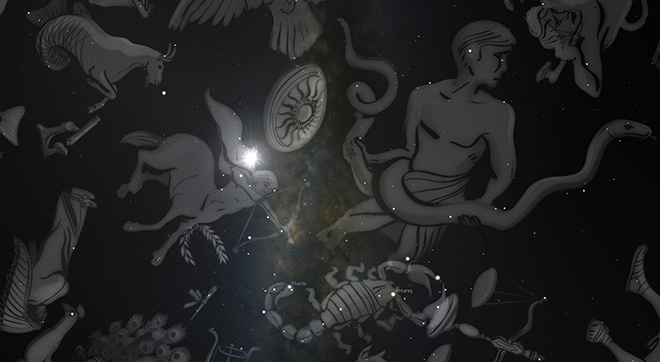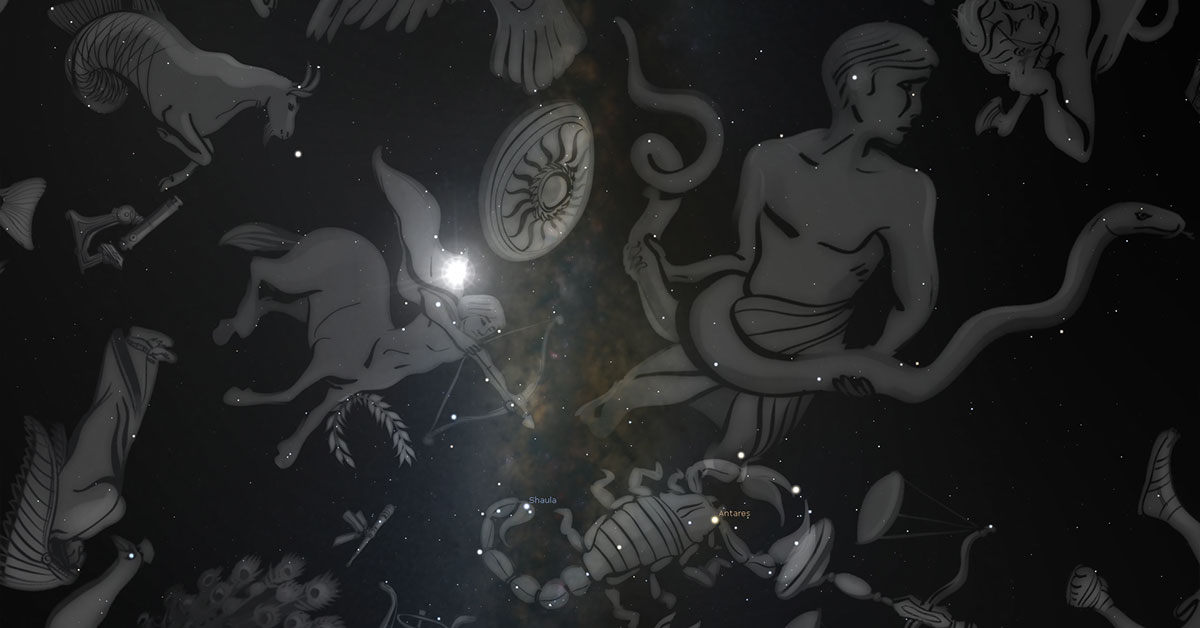
In episode 60 of the podcast astrologers Kenneth Miller and Nick Dagan Best join the show in order to help me tackle the zodiac debate, and discuss the differences between the tropical and sidereal zodiacs.
Below are notes on some of the topics that we discussed in the episode, followed by the link to listen to the recording of this episode of the podcast.
Outline of the Episode
Here is an outline of some of the main points that we focused on during the course of this episode, based on the show notes that were prepared before we talked:
- There are three zodiacs: constellational, sidereal, and tropical.
- For more info on this see: The Tropical, Sidereal and Constellational Zodiacs.
- Started with the constellations along the ecliptic.
- Ecliptic is the path the planets take across the sky. Only goes through certain constellations
- By the 5th century BCE the zodiacal signs were standardized in Mesopotamia.
- Sidereal zodiac with 12 signs of 30 degrees each.
- The constellations themselves are uneven, but the “signs” are not.
- Later by the 2nd century we see Ptolemy firmly adopt the tropical zodiac.
- Based on the solstices and the equinoxes.
- More connected with the seasons.
- In this period the zodiacs were roughly aligned, so there was no issue.
- Due to precession they move about 1 degree every 72 years.
- Minor change in a lifetime, but adds up over centuries.
- 25,772 years for a complete cycle
- Today the tropical and sidereal zodiacs differ by about 24 degrees.
- Subtract about 24 degrees from a tropical position to get sidereal position.
- A planet at 14 Aries in tropical is around 20 Pisces in sidereal.
- Who uses tropical now?
- Tropical is primarily used by western astrologers since the middle ages.
- All Sun-sign columns use the tropical zodiac.
- Who uses sidereal?
- Sidereal mainly used by Indian astrologers.
- In the 20th century some western astrologers started using sidereal. General called “western sidereal astrology” now.
- Brings us today where there is a debate between astrologers about which is best to use.
- This is a genuine technical debate that has decent pros and cons on both sides.
- It is complicated by the long traditions behind each, and the tendency for astrologers to identify with their chart placements.
- Separate issue is the use of precession as an attack vector by skeptics.
- Astrologers have to settle this as a technical, conceptual, and practical issue.
- Some questions to ask:
- Do tropical and sidereal astrologers use the zodiac in the same way?
- Do they attribute the same qualities to the signs?
- Is it the case that one approach is valid and the other is not valid?
- Or is it possible that both are valid in some way?
- Attempts to answer the question from a historical perspective:
- One potential way of answering this is figuring out what zodiac the ancients originally intended to use.
- The problem in the Hellenistic tradition is that they seem to have drawn on both tropical and sidereal considerations.
- Ultimately what we have to do is go back to the fundamentals and figure out where we are getting each concept from: rulership, modalities, gender, etc.
- There are important problems that supporters of both approaches still have to resolve:
- Tropical issues:
- If the zodiac is based on the seasons, then you run into an issue since the seasons are flipped in the northern and southern hemispheres.
- This is an issue for the quality of the signs, but also potentially for the rulerships.
- Either the zodiac should be flipped, or astrologers need to come up with a reason for why the vernal point can act as a starting point that is true in both hemispheres.
- Tropical astrologers from the southern hemisphere like Australia often report that the zodiac works just fine as is, and should not be flipped. Are they correct, or is this open to question?
- Sidereal issues:
- There is no universally agreed upon starting point for the zodiac in sidereal.
- Since the “signs” are idealized and don’t line up with the constellations perfectly it is not clear where zero degree of Aries should be.
- The ayanamsha is the difference between the tropical and sidereal zodiac.
- Different astrologers use different fixed stars and other points to start with.
- There is a separate issue of whether the idealized signs should be used, or if the actual constellations of varying length should be used.
- If the constellations then should ones like Ophiuchus be incorporated?
- Final thoughts.
- No one has really worked out a good methodology for testing this issue.
- Astrologers often test it using charts, but sometimes they use precession and historical events and other things.
- With the problems outlined clearly now at least we can all approach this with a better understanding of what we are dealing with.
Transcript
A full transcript of this episode is available: Episode 60 transcript
Listen to This Episode
You can either play this episode of the podcast directly from the website or download it as an MP3 to your computer by using the buttons below:
Podcast: Play in new window | Download (Duration: 2:15:28 — 62.2MB)
